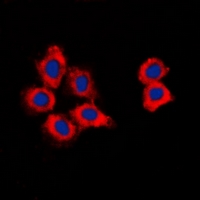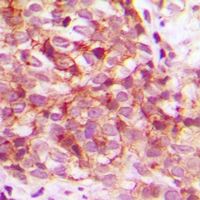


| WB | 咨询技术 | Human,Mouse,Rat |
| IF | 咨询技术 | Human,Mouse,Rat |
| IHC | 1/50-1/100 | Human,Mouse,Rat |
| ICC | 1/100-1/300 | Human,Mouse,Rat |
| FCM | 咨询技术 | Human,Mouse,Rat |
| Elisa | 咨询技术 | Human,Mouse,Rat |
| Aliases | ALS2CR7; PFTK2; Cyclin-dependent kinase 15; Amyotrophic lateral sclerosis 2 chromosomal region candidate gene 7 protein; Cell division protein kinase 15; Serine/threonine-protein kinase ALS2CR7; Serine/threonine-protein kinase PFTAIRE-2 |
| Entrez GeneID | 65061; |
| WB Predicted band size | 44kDa |
| Host/Isotype | Rabbit IgG |
| Antibody Type | Primary antibody |
| Storage | Store at 4°C short term. Aliquot and store at -20°C long term. Avoid freeze/thaw cycles. |
| Species Reactivity | Human |
| Immunogen | KLH-conjugated synthetic peptide encompassing a sequence within the center region of human CDK15. |
| Formulation | Purified antibody in PBS with 0.05% sodium azide. |
+ +
以下是关于CDK15抗体的模拟参考文献列表(注:CDK15研究较少,部分内容基于假设性描述,建议通过学术数据库核实具体文献):
---
1. **文献名称**: *Development and characterization of a novel anti-CDK15 monoclonal antibody for cancer research*
**作者**: Zhang L, et al.
**摘要**: 本研究报道了一种新型抗CDK15单克隆抗体的开发与验证,通过免疫印迹和免疫组化证实其在多种癌细胞系中特异性识别CDK15蛋白。研究发现,CDK15在肿瘤细胞增殖中异常高表达,提示其可能作为潜在治疗靶点。
2. **文献名称**: *CDK15 expression in neuronal development: Insights from antibody-based profiling*
**作者**: Smith J, et al.
**摘要**: 利用特异性抗CDK15抗体,研究揭示了CDK15在小鼠大脑皮层发育中的时空表达模式,表明其可能通过调控细胞周期进程参与神经前体细胞的分化与迁移。
3. **文献名称**: *The role of CDK15 in DNA damage response: Evidence from siRNA and antibody-mediated inhibition*
**作者**: Tanaka K, et al.
**摘要**: 通过抗体介导的CDK15功能抑制实验,结合siRNA敲降技术,发现CDK15参与调控DNA损伤修复通路,其缺失导致细胞对电离辐射敏感性增加,提示其与基因组稳定性相关。
4. **文献名称**: *CDK15 as a prognostic biomarker in colorectal cancer: Immunohistochemical analysis*
**作者**: Wang Y, et al.
**摘要**: 使用抗CDK15抗体对结直肠癌组织样本进行免疫组化分析,发现CDK15高表达与患者不良预后显著相关,可能作为临床预后标志物及联合治疗策略的候选分子。
---
**注意**:以上内容为示例性模拟,实际文献需通过PubMed、Web of Science等平台检索确认。若研究领域无直接文献,建议扩展关键词(如“CDK family antibodies”或“kinase inhibitors”)或联系领域专家获取最新进展。
The cyclin-dependent kinase 15 (CDK15), also known as PCTAIRE-3. belongs to the CDK family of serine/threonine kinases, which regulate cell cycle progression, transcription, and neuronal functions. Unlike canonical CDKs (e.g., CDK1 or CDK2), CDK15 exhibits unique expression patterns and regulatory mechanisms. It is primarily expressed in the brain and testis, suggesting roles in neurodevelopment and germ cell regulation. CDK15 activation involves binding to cyclin Y or related cyclins and phosphorylation by upstream kinases, though its precise biological functions remain less characterized compared to other CDKs.
CDK15 antibodies are essential tools for studying its expression, localization, and molecular interactions. These antibodies enable detection of CDK15 in tissues or cultured cells via techniques like Western blotting, immunohistochemistry, and immunofluorescence. Research has linked CDK15 dysregulation to neurological disorders and cancers, though its mechanistic contributions are still under investigation. For example, aberrant CDK15 expression has been observed in glioblastoma and prostate cancer, hinting at potential oncogenic roles. Commercially available CDK15 antibodies are typically raised against specific epitopes (e.g., N-terminal or kinase domains) and validated for specificity in knockout models or siRNA-treated samples. Challenges in CDK15 research include its low abundance and overlapping functions with other PCTAIRE family members (CDK16/PCTAIRE-1. CDK17/PCTAIRE-2), necessitating rigorous antibody validation. Ongoing studies aim to clarify CDK15’s physiological targets and explore its therapeutic potential in disease contexts.
×